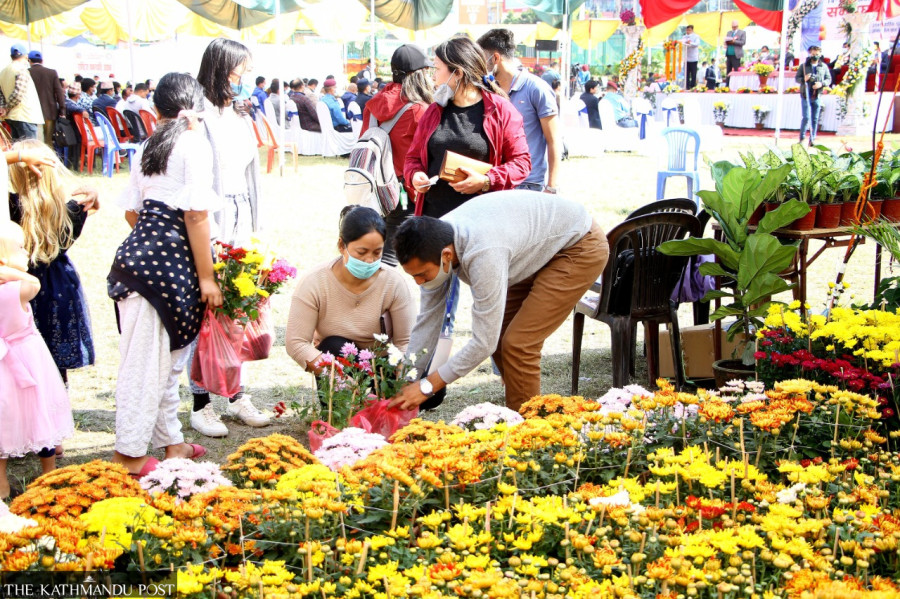Money
Flower industry rebounds on festive celebrations
According to the Floriculture Association Nepal, the total flower trade during the four-day Tihar festival amounted to Rs152 million.
Krishana Prasain
Demand for flowers has recovered to almost pre-coronavirus levels in the festival celebration mood as the country opened up after lockdowns.
The floriculture sector had suffered a big blow due to the Covid-19 pandemic in the last two years as the government banned all public gatherings, festivals and official events. The demand for flowers used in religious ceremonies evaporated.
But the Tihar festival that ended on Sunday proved to be a bonanza for the floral industry. Florists say that the business is back on its feet, faster than expected.
According to the Floriculture Association Nepal, the total flower trade during the four-day Tihar festival amounted to Rs152 million.
The association said that 1.89 million marigold garlands worth Rs127 million were sold during Tihar. Similarly, 305,000 makhmali garlands worth Rs1.67 million, 15,000 godawari garlands worth Rs5.25 million and 100, 000 makhmali garlands worth Rs3 million were sold.
“We met the sales target as expected,” said Min Bahadur Tamang, president of the association. “As there were no Covid restrictions and virus cases dropped significantly, the festival drove flower demand.”
He said that flowers were available at a cheaper rate from India and that was another factor that drove demand up.
This year, a marigold flower was priced at Rs60-80 per garland. A one-metre-long garland contains 40 flowers.
Similarly, globe amaranth (makhmali garlands) was available at Rs40-70 per garland, as per the association.
Due to Covid-19 during the last Tihar, around 1.6 million garlands were sold last year, which was valued at less than Rs120 million.
As the country has become self-reliant in globe amaranth flower, more than 100,000 garlands worth Rs3 million were exported to different countries, the association said.
Due to a decline in production in Nepal triggered by the unseasonal rainfall in October, the association had expected that 15 percent of the deficit would be fulfilled by imports.
But traders said that there was a massive import from India and flowers were available at a cheaper rate.
“Traders who were not members of the floriculture association imported flowers from India half a month ago and kept them in cold storage,” according to the association. More than 30 percent of flower demand was fulfilled by imports, the association said.
The increased imports have worried Nepali florists.
As per the association, the marigold flower market in Nepal is facing stiff competition. “It cannot compete with Indian flower producers as the Indian government offers up to 80 percent in subsidies to growers, '' the association said.
Garlands—globe amaranth or marigold flowers strung together for the occasion—hold huge cultural significance during this festival as sisters put them around their brothers' necks on the special day honouring their sacred bond.
According to the association, flowers for this year's Tihar festival were commercially produced in 32 districts of seven provinces. The produced flowers were affected by unseasonal rainfall in Tarai and some hill areas of Province-1, Bagmati Province, Lumbini Province, Gandaki Province and Sudurpaschim Province.
Heavy rainfall is unusual in October, which is traditionally outside the monsoon season in Nepal.
The downpour started on October 17 in the western part of Nepal and moved east on October 19, claiming lives and damaging roads, bridges and other physical infrastructure besides standing crops in various districts.
The rain also destroyed ready-to-harvest flowers, particularly marigold.
Vibrant yellow marigolds and milky white chrysanthemums are necessary offerings to the goddess of wealth Laxmi during Tihar.
Colourful blossoms are a major item during the festival as people festoon the doors and windows of their houses with strings of flowers, and sisters place garlands around the neck of their brothers as part of the rituals.
According to the association, floriculture is done on 158 hectares and around 44,000 people are directly and indirectly engaged in the sector.
There are 800 commercial floriculturists in the country with a combined investment of Rs6.5 billion.




 6.12°C Kathmandu
6.12°C Kathmandu














